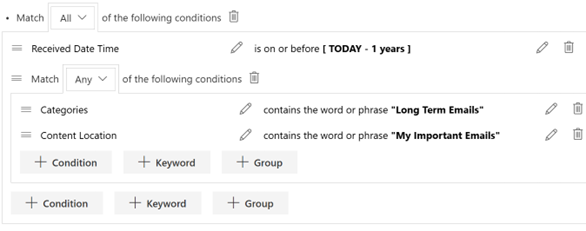Being able to review related content during a discovery search project is valuable to ensure that all necessary files are captured. Whether that means you are garnering insights for streamlined discovery queries, fulfilling a GDPR, FOIA or ATIP request or retrieving information to optimize work operations and records management, keeping on top of your organization’s content is predicated on you being able to quickly discover and access relevant information.
One way to do this is by using a cross-platform cloud tool that allows you to search across your go-to repositories from a single platform. Collabspace, specifically, has a More Like This feature that you can use to see related content and discover insightful connections you might not have otherwise considered.
This article will cover exactly how the More Like This feature works to manage your organization’s data footprint…
How searching for content leads to finding similar content, with the advantages of:
Some common use cases scenarios to show how "More Like This" brings value, including:
- Building case files for Legal eDiscovery
- Email correspondence and security
- Filling out forms
- Purchase agreements
How More Like This Works
How searching for content leads to finding similar content
In today’s information-saturated world, finding content that is relevant to your needs starts from a search result and finding ways to expand upon those interests with a calculated relevancy. From recommended videos based on what you’ve watched last, or related blog articles that branch off from the one you’ve just read, the expansive web of information customizes content based on the context provided to the user.
In the same way, Collabspace assists navigating the amount of information generated by organizations each day by providing enhanced discovery and information recall across the sprawl of their respective data. Building upon Collabspace’s Data Lake design principle, by connecting to all an organization's content sources from one integrated platform, the More Like This tab can show and collate content in either Preview mode or in a file's lifecycle details window. This offers two significant advantages: detecting Duplicates or identifying Similar Items.
1. Discovery of Duplicate Content Items
Let’s say your organization has a policy document that’s sent downstream to different departments, such as a waiver. Over time, distributing it across various employee hands and email accounts could lead to many copies being saved across content sources and revisions being made. In the day-to-day tasks of working in a digitized work environment, how would you keep track of all the versions created, the most recent revision and who's version is the most important?
By actioning on the Duplicates portion of the More Like This tab, Collabspace executes this by locating duplicate content items matching the Collabspace Checksum ID. Now, across the connected content sources that pool into your organization’s data lake, you will be able to find all versions of this document, no matter where they are.
Being able to locate duplicate content items not only elevates a Content Management Strategy, but saves your organization money in operational and storage costs and helps your team manage redundancies by identifying excessive retention across your content sources. We delve into a use case showing how, next.
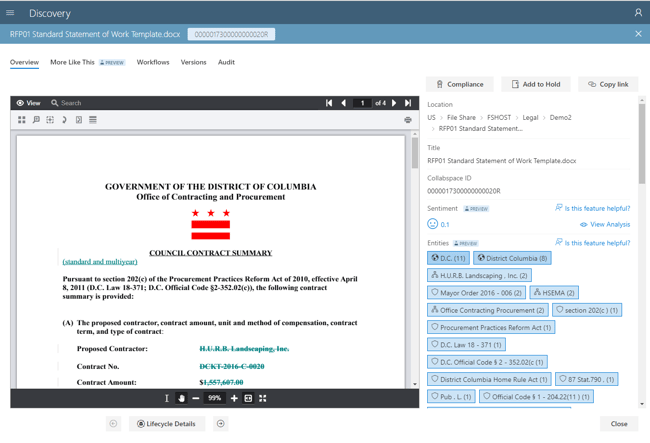
In this example, we’ll examine an RFP template. If we wanted to find other instances of this document across all of our connected content sources in our organization’s data lake, it's as simple as: 1) Entering the Preview panel or Lifecycle Details of the content item (shown in the screenshot above), and 2) Clicking on the More Like This tab (shown below).

If you’re worried about having multiple copies of documents in different places, now you can find them and decide which version suits your needs. Additionally, managing your content this way empowers users to cut on excessive storage costs by allowing more efficient use of data and Collabspace compute segments.
2. Actioning on Similar Content Items
 Think of how you would implement a typical search. To find similar content, the search would ordinarily be too broad, such as searching through specific file locations and email inboxes, or too specific, such as using terms, document titles, or content types. Additionally, the library-standard Boolean approach is inherently limited by your own knowledge base to inform how to formulate specific queries with the exact wording to find what you need.
Think of how you would implement a typical search. To find similar content, the search would ordinarily be too broad, such as searching through specific file locations and email inboxes, or too specific, such as using terms, document titles, or content types. Additionally, the library-standard Boolean approach is inherently limited by your own knowledge base to inform how to formulate specific queries with the exact wording to find what you need.
Where the More Like This feature really shines is in its ability to assist follow-up discovery on the content itself for optimized search strategy. Collabspace allows a user to use a piece of content itself to find related files across all connected content sources. Instead of searching for something in of itself, this tab considers the context of the content and produces related results based on this. And by using the Content Summary, which embodies the terms in the written contents as well as contextual cues, it is easier to follow up on a discovery search than having to parse out keywords every time. This approach can be useful in the following scenarios:
Applicable Common Use Case Scenarios for Related Content
Building Case Files for Legal eDiscovery
Starting with search results related to a person or project, using More Like This could be used to branch off and find other content which could be potentially related to a litigation case during a legal hold. Using Similar Items would increase the efficiency of this process. Because it's based off Content Summary, this feature could also be used to find items that you wouldn't think were related at first.
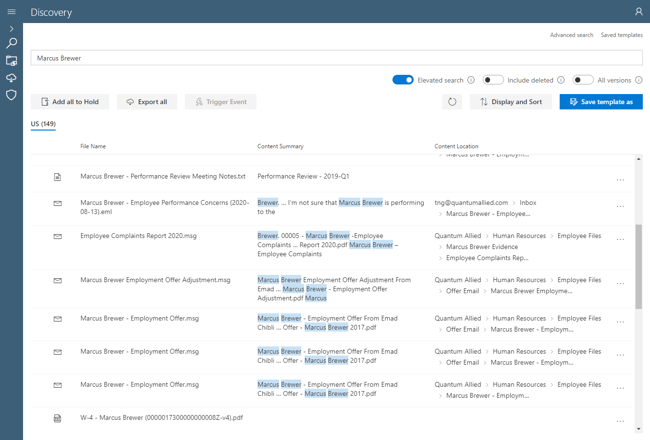
In this example, we are building a case file on an employee named Marcus Brewer and searching for this name brings up everything related to him, whether it’s ultimately related to the case or not. Say we are searching specifically for this employee’s performance reviews, we can find similar content to isolate and put on hold easily.
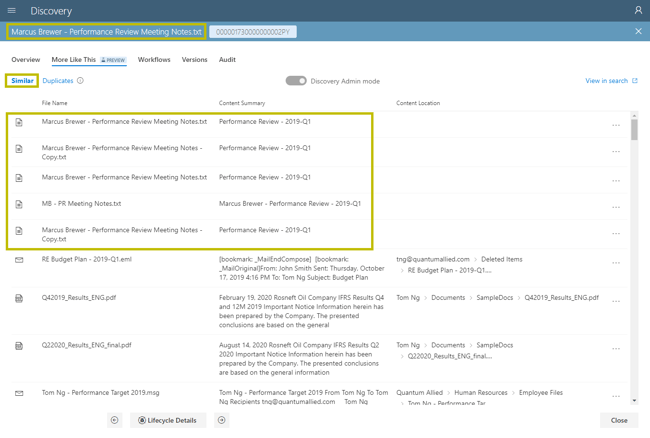
Collabspace’s More Like This feature empowers you to find the records you require by actioning on specific files. Time is money, and this through-line reduces the time needed for reviewing documents required from consultant parties or lawyers, not only resulting in a more efficient legal discovery process, but saving costs on expensive hourly legal billing.
Related Email Correspondence and Security
By applying an email through the Similar Items tab, other emails contained in relevant threads will be discovered, such as responses or forwarding from connected inbox accounts. Related subject lines, user accounts and potentially relevant content items will also be discovered. Finding past correspondence and parties who have received emails through related threads, subjects, and can be expanded to related clientele, locating sales tenders and previous bids or Similar Projects.
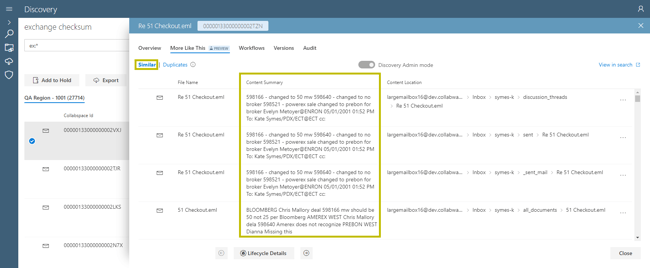
For security purposes, this would also be effective for finding phishing or ransomware emails that employees have encountered. Once reported, IT administrators can use the More Like This tab to find other instances of these security risks across all mailboxes connected to the organization by finding emails that look similar in format, style and content.
How do I fill out this form?
 To fulfill standardized procedures and working practices, there may be times where you do not know how to fill out a form and want to find a working example that has been completed previously. By utilizing Similar Items on the content you already have, discovering how it was done is as simple as one click. This will narrow down your search to provide you with the confidence you need for meeting the standards expected by your organization.
To fulfill standardized procedures and working practices, there may be times where you do not know how to fill out a form and want to find a working example that has been completed previously. By utilizing Similar Items on the content you already have, discovering how it was done is as simple as one click. This will narrow down your search to provide you with the confidence you need for meeting the standards expected by your organization.
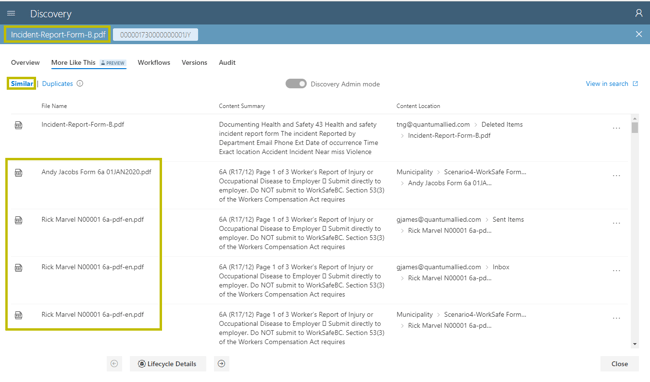
Purchase Agreements with Past, Present and Potential Clientele
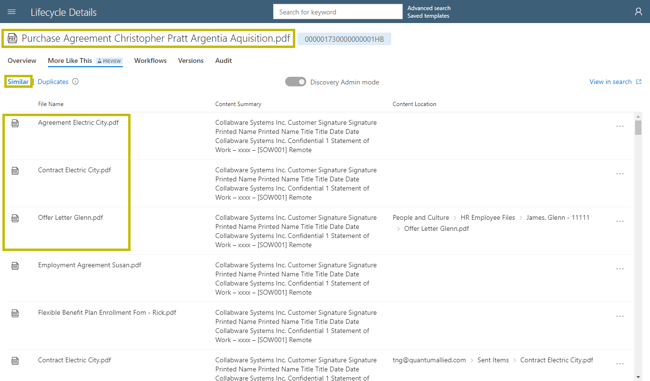
This feature can also bring value when looking to improve your sales initiatives or closing a deal with a particular prospect. When searching for completed sales tenders in your organization’s data lake, finding correspondence with similar clients is made easier, even if you hadn’t thought of them or they hadn’t yet been brought to mind.
In the example screenshot shown above, searching for similar items to a past purchase agreement in your organization brings up other purchase offers and contract proposals across the various content sources connected to Collabspace. Staying on top of this with Similar search keeps your money-making opportunities on hand with ease, and allows you to see patterns to better improve your sales processes for future deals.
Integration into Collabspace Discovery
If that wasn’t enough, these features have also been retrofitted into the already powerful Collabspace Discovery tools that are available to users to supplement your search capabilities.
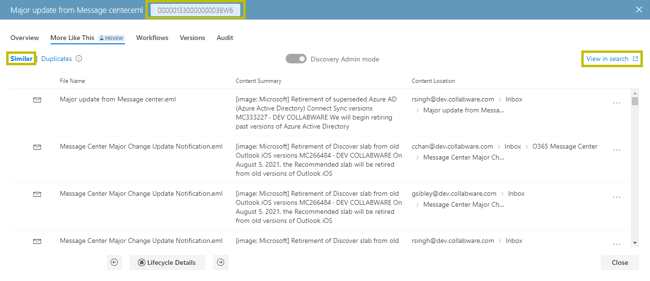
Let’s say you’ve received a notification for a major update and want to stay on top of others you might have missed. Clicking View In Search will navigate a user from the More Like This tab to a new browser tab displaying the similar or duplicate items in a Search Results view.
This will also prompt you on how to perform a Search in Discovery by using the prefixes “similar:” or “duplicates:” followed by the Collabspace ID of an item to input a query for similar or duplicate items to that specific content. This streamlines the discovery process by allowing for a more precise search based on fulfilling established similarities modeled after a specific file based on its content summary rather than basing a search for similar items on terminology and syntax.
Conclusion
By using the content itself to find related information, the More Like This feature in Collabspace provides users with an easier, faster way to find information than pursuing the content directly by navigating a typical storage system source by source, by providing context to the content.
You can use this feature to bring up duplicates to find the latest version of your project and see where copies are stored to reduce storage costs. Or, take advantage of actioning on Similar Items to streamline discovery projects from legal eDiscovery to purchase agreements. Whatever your purpose, More Like This allows you to dig deeper, examine more, qualify, or disqualify content, to better see different facets on a search subject and gather insights that could lead to business optimization.
Want to see how this feature (and others) can bring immediate value to your organization? Contact us with your questions or for a free demo. We’ve also written articles about how Collabspace features, such as automated workflows and features for legal holds, can optimize your processes.
And for an overview of our data lake cloud solution, Collabspace, and how it can optimize your discovery, download our free brochure below for the full overview:
![]()



